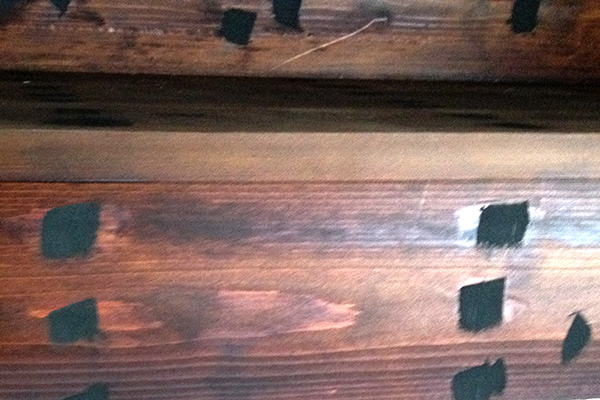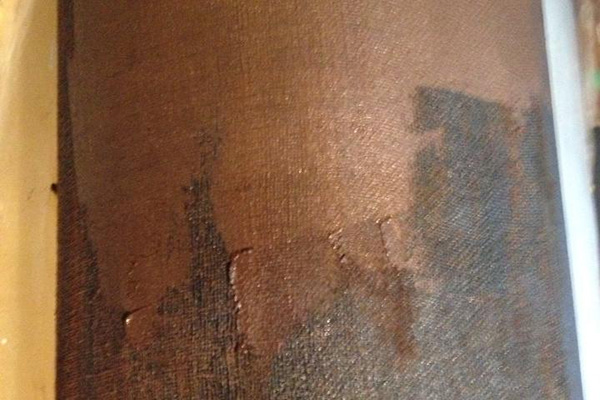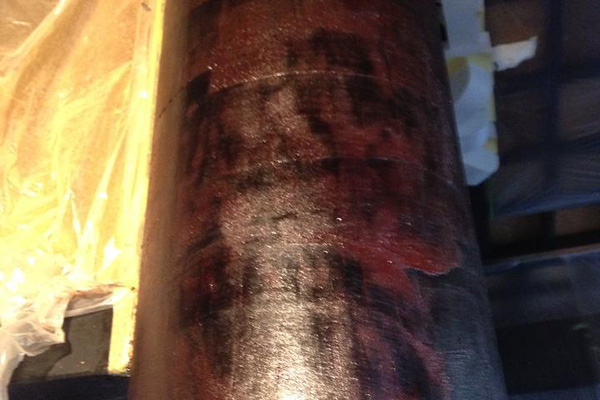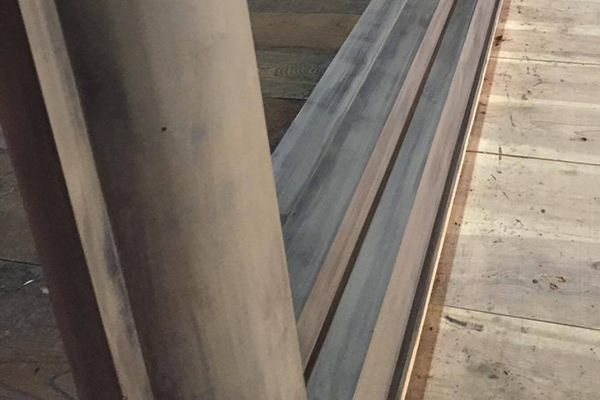Benefits of applying Urushi
- Expression of traditional beauty and luxury
- Improved durability of wood (waterproof, antifungal, pesticide, antibacterial, etc.)
Shitaji (Base)type
- Honkataji base Because lacquer is used by the traditional method, it is the most waterproof and durable, but the most expensive. There are many processes and the difficulty is high. The finish is beautiful. The construction method that we mainly use.
- Doroji base Handaji base Traditional method that we do not use. Due to the use of animal glue, it lacks waterproofness and durability. It is hard to get spoiled.
- Base using chemical paint We do not use chemical putty, surfacer, cashew, urethane paint, etc. Although it is waterproof, it quickly loses its shape and deteriorate.
Process (Honkataji base〜Roiro mirror finish)

1. Wood adjustment
If there is an existing painted surface, peel it off to expose the wood. Fill cracks, holes and knots in wood and repair with wood and kokuso. (* Kokuso = raw urushi + rice paste + zelkova powder + linen powder)
(* Kokuso = raw urushi + rice paste + zelkova powder + linen powder) At our company, in order to prevent peeling and floating after completion, the original paint is completely peeled off and work starts from the bare wood.
* Adhesive may be used only when repairing damaged parts of wood.

2. Hardening the wood
The wood is impregnated with raw urushi diluted with turpentine *. Ensure waterproofness and harden unstable parts with urushi. (* Turpentine oil = oil taken from pine resin)

3. Paste the cloth
Stick linen cloth to the wood with glue urushi. To prevent cracking and spoiling. (* Glue urushi = raw urushi + rice glue)

4. Erase the texture
Knifing the kiriko putty to fill the texture and flatten it. (* Kiriko putty= raw urushi + jinoko soil and tonoko soil)(jinoko is coarse-grained soil and tonoko is fine-grained soil. Both are red clay)

5.ji knifing
Knifing “ji” putty. To ensure sufficient strength of the base. (* Ji putty = raw urushi + rice glue + jinoko soil)

6.Kiriko and Sabi knifing
Repeat knifing and sharpening “kiriko” putty and “sabi” putty to form the groundwork. (* Sabi putty= raw urushi + tonoko soil)

7. Sharpening
After knifing all the base putty, sharpen it flat with a whetstone.

8. Harden the groundwork
The sharpened substrate is impregnated with raw urushi diluted with turpentine.

9. Undercoat, middle coat
Apply the middle coat urushi with a urushi special brush made of human hair. Proceed in the order of undercoat → drying → polishing → intermediate coating → drying → sharpening. (* Middle coat urushi = relatively inexpensive black urushi that does not contain oil)

10. Topcoat
Apply nuritate urushi or roiro urushi with a special urushi brush made of human hair. In the case of nuritate urushi, it is completed when it is dried and cured. ● Nuritate urushi → High-quality urushi mixed with oil to make it glossy ● Roiro urushi → High-quality urushi without oil.

11. Charcoal sharpening (hereinafter roiro process)
Using charcoal called Suruga charcoal and Shizuoka charcoal and a special whetstone, sharpen the coating film of roiro urushi that has been dried and hardened.

12.Douzuri polishing
Rub in tonoko soil or charcoal powder that has been roasted with fire, and further make the texture of the painted surface finer.

13. Raw urushi rubbing-Roiro polishing
Rub in high-quality raw urushi called Ise Haya, and when it dries and hardens, polish it with bare hands using deer horn powder.

Complete
The pillar is finished with roiro. The pillar is on the left from the ▲ part. You can see that the details of the ceiling are reflected without distortion.
About the time required for drying and curing urushi
“If the temperature and humidity are high, the drying and curing will be good, and if the temperature and humidity are low, the drying and curing will be slow.
Work is suitable from May to October. It may be necessary to control the temperature and humidity from November to April, but work is possible. In that case, the work period will be slightly longer.”
